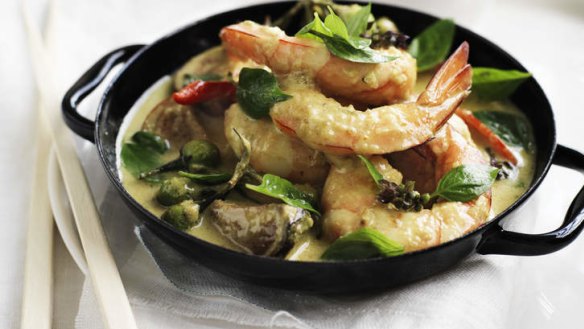Can you freeze green curry?

Recently I froze a Thai green curry. When I defrosted it looked disgusting. G. Valenti
Thai green curry is made with coconut cream, an emulsion of coconut oil and water. If you're using tinned coconut cream it will most likely have been homogenised and had stabilisers and emulsifiers added to it. When you freeze the curry, water forms ice, which separates the coconut oil out of the emulsion. This is called splitting. Conversely do not cook your green curry in a pressure cooker as some coconut proteins denature at around 120C, making the sauce look curdled.
Is it still necessary to lay the wine bottles with screw caps down on their sides as for bottles sealed with cork? M. Kennedy
I do miss the delicious pop a cork made as it was pulled from a bottle. The metallic crack of an aluminium screw cap having its seal broken doesn't induce the same Pavlovian response I'm afraid. I think we all know that wine was laid down on its side to keep the cork moist so it wouldn't shrink and allow air in to spoil the wine. The trouble was that a fungus in cork was producing a compound known as TCA, which gave rise to cork taint. Aluminium seals have a soft synthetic layer that presses hard on the glass, sealing the wine from the outside world. This seal doesn't need to be kept moist so you can stand bottles upright. A great mate who is both a winemaker and a restaurateur says that just because a bottle is under an aluminium screw cap doesn't mean you should not "try" the wine you have ordered at a restaurant. "There are some faults that can develop in the winery, even contamination by TCA," he says. "And while this has never happened in my wines, fingers crossed, I suggest you always try the wine. It's part of the charm of dining in public."
Why do some grocers keep their tinned anchovies in the fridge? D. Gregor
I watched people preserving anchovies in the north of Spain. The anchovies were fermented in brine that was like thick rusty water that was so salty that salt crystals were forming around the rim. During this process, the anchovy loses a lot of moisture and some of its oils while the protein in the flesh breaks down and cures – as flesh does as in jamon or prosciutto making. The fillets were hand peeled from the spine and packed in tins with a mix of canola and olive oil and were sealed but not pasteurised. These products are called semi conservas or semi cured. This means that while preserved they are not as shelf stable as, say, tinned tuna, which has been pasteurised. While they are airtight and won't go off, the delicate flavour of the fish can be compromised when exposed to heat so good importers and retailers ship and store these quality anchovies in the fridge.
When I go to England what is the scum on the top of tea? K. Murphy
English tea scum? Sounds like a Dickensian underclass. Parts of England are supplied with hard water. This is water that has high levels of naturally occurring chemicals such as calcium carbonate. This happens when water percolates through layers of calcium-rich rock such as limestone, chalk or dolomite. The dissolved calcium reacts with compounds in the tea that rise to the surface and create a rainbow-coloured sheen. This scum can be avoided by adding a few drops of lemon juice or other similar edible acidic liquid or compound to the water before making the tea. The varying quality of water across Britain is one reason there are different blends of tea for different parts of the UK.
Letters
Here at the Brain Food Institute we recently suggested that if you were going to prepare meat for mincing then, "Firstly trim the meat of silver and connective tissue. Cut into 2 centimetre by 1 centimetre pieces." A Mr. P. Pendante wrote in with this abrupt little missive. "Cut into 2 centimetre by 1 centimetre pieces. By what, a metre?" We thank you Mr. Pendante for your vigilance.
If you have a vexing query email brainfood@richardcornish.com.au
Twitter: @Foodcornish
The best recipes from Australia's leading chefs straight to your inbox.
Sign up- More:
- Brain food
